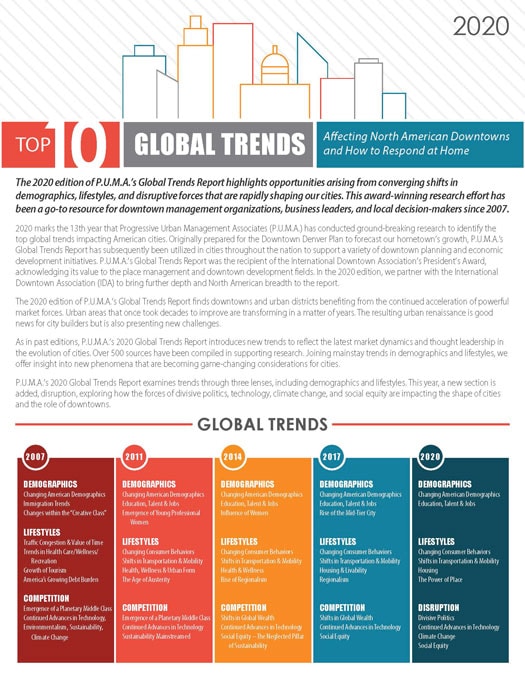
In 2006, a Denver, Colo., company called Progressive Urban Management Associates, P.U.M.A., (yes, like the shoes, only with periods), started looking at data to determine trends that would affect downtowns. They have been remarkably accurate in their trendspotting, forecasting global changes that have proven good for downtowns. Their earliest trends showed millennials’ love of urban areas, how sustainability played into the desire to rehab and renew historic buildings and focused on how traffic congestion and how the costs in time was encouraging people to move back to city centers from the far-flung suburbs. It is important to both note and understand these trends as they not only help shape our historic downtown, but our city as a whole. Over the years since the very first Top 10 Global Trends Report, we have seen other trends develop, some with frightening rapidity. Changing consumer behaviors seemed to hit almost overnight, affecting brick-and-mortar retail around the country. One day Amazon was a river, the next, it was a global behemoth sending every conceivable product to your door in two days and with free shipping. Business models of banks, media outlets- even grocery stores- changed dramatically. The Main Street whose biggest business was a Blockbuster Video was sent scrambling for a replacement. Technological changes allowed people to ‘cut the cord’ and drop cable and satellite TV to switch to streaming options that allow them to watch anything they want at any time. Sometimes it seems almost overwhelming. Thank goodness for the constancy shown in the 2020 P.U.M.A. report. Interest in downtowns continues to trend, and mid-size cities like Shreveport can capitalize. Over the past decade, people have flocked to what P.U.M.A. calls ‘Superstar’ cities. I would put places like Austin and Dallas, Tex., in this category. For years these urban centers could do no wrong and grew at a remarkable pace. They are still strong and vibrant communities, but their growth is now creating significant strain. Drive times are growing ever longer, and costs are skyrocketing to live and work there. Home ownership of even a 500 SF condo or townhouse near downtown Austin or Dallas is beyond the ability of many and apartment and office rents are increasing, as well. We should not let this moment pass us by. Smaller and mid-size cities like Shreveport can emerge as a new ‘opportunity city.’ We can capitalize on affordable living options, our remarkable quality of life and opportunities for civic involvement. We can take advantage of yet another trend by just being ourselves as opposed to trying to emulate others. We’ll never be an Austin, but we can be an amazing Shreveport. Our buildings tell a tale, our history is remarkable, our people, captivating. Many of the P.U.M.A. trends spotlight things we are already doing, paths we have taken but we can -and-should- do better. We must continue to work to make our downtown a welcoming haven for women and people of color, as they will increasingly dominate our workforce. We will continue to push for a transit-rich urban center, adding bicycle rentals and other ‘on-demand’ transportation to our current bike lanes and parking app. Brick and mortar is down, but not out. We must encourage our retail stores to continue to offer unique or one-of-a-kind items, memorable experiences and personalized customer service to keep people returning. Soon, we will create a full-time space to host temporary retail and Pop-Up concepts. High quality housing with different price points to cater to everyone from those just starting out to those at their salary peak continues to be our goal, and our 2020 goal is to encourage property owners to consider adding apartments to vacant second-floor spaces downtown. All the trends for downtowns are encouraging, but trends alone aren’t enough. It’s going to take work and effort, community support, some money, and a little luck. We’re game. Are you?




